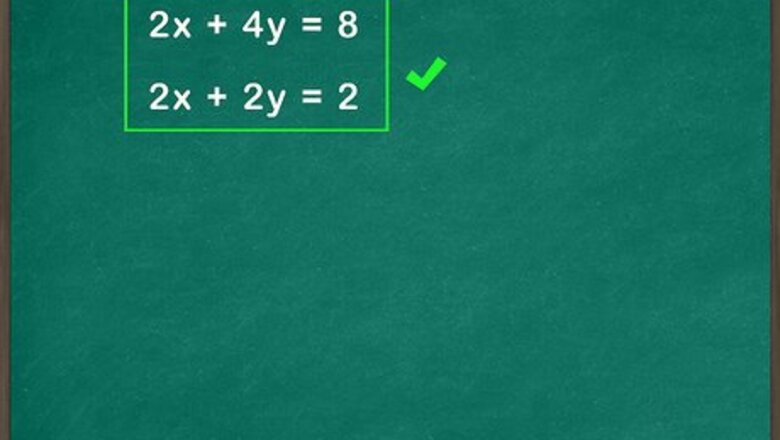
views
Solve by Subtraction

Write one equation above the other. Solving a system of equations by subtraction is ideal when you see that both equations have one variable with the same coefficient with the same charge. For example, if both equations have the variable positive 2x, you should use the subtraction method to find the value of both variables. Write one equation above the other by matching up the x and y variables and the whole numbers. Write the subtraction sign outside the quantity of the second system of equations. Ex: If your two equations are 2x + 4y = 8 and 2x + 2y = 2, then you should write the first equation over the second, with the subtraction sign outside the quantity of the second system, showing that you'll be subtracting each of the terms in that equation. 2x + 4y = 8 -(2x + 2y = 2)
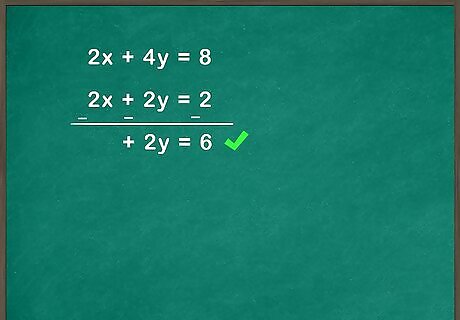
Subtract like terms. Now that you've lined up the two equations, all you have to do is subtract the like terms. You can take it one term at a time: 2x - 2x = 0 4y - 2y = 2y 8 - 2 = 6 2x + 4y = 8 -(2x + 2y = 2) = 0 + 2y = 6
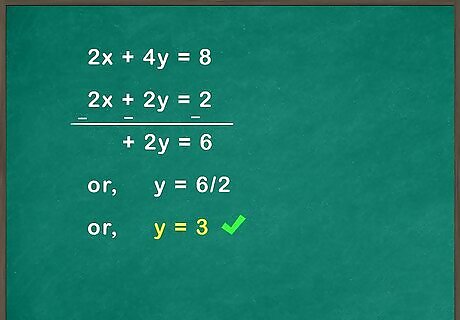
Solve for the remaining term. Once you've eliminated one of the variables by getting a term of 0 when you subtract variables with the same coefficient, you should just solve for the remaining variable by solving a regular equation. You can remove the 0 from the equation since it won't change its value. 2y = 6 Divide 2y and 6 by 2 to get y = 3
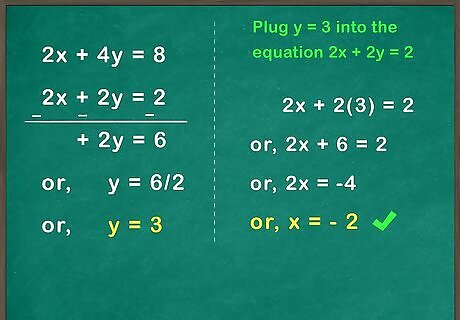
Plug the term back into one of the equations to find the value of the first term. Now that you know that y = 3, you just have to plug it in to one of the original equations to solve for x. It doesn't matter which one you choose because the answer will be the same. If one of the equations looks more complicated than the other, just plug it into the easier equation. Plug y = 3 into the equation 2x + 2y = 2 and solve for x. 2x + 2(3) = 2 2x + 6 = 2 2x = -4 x = - 2 You have solved the system of equations by subtraction. (x, y) = (-2, 3)

Check your answer. To make sure that you solved the system of equations correctly, you can just plug in your two answers to both equations to make sure that they work both times. Here's how to do it: Plug (-2, 3) in for (x, y) in the equation 2x + 4y = 8. 2(-2) + 4(3) = 8 -4 + 12 = 8 8 = 8 Plug (-2, 3) in for (x, y) in the equation 2x + 2y = 2. 2(-2) + 2(3) = 2 -4 + 6 = 2 2 = 2
Solve by Addition
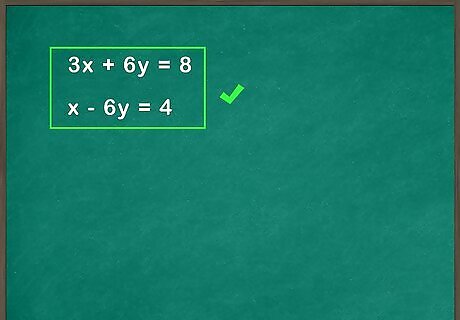
Write one equation above the other. Solving a system of equations by addition is ideal when you see that both equations have one variable with the same coefficient with opposite charges. For example, if one equation has the variable 3x and the other has the variable -3x, then the addition method is ideal. Write one equation above the other by matching up the x and y variables and the whole numbers. Write the addition sign outside the quantity of the second system of equations. Ex: If your two equations are 3x + 6y = 8 and x - 6y = 4, then you should write the first equation over the second, with the addition sign outside the quantity of the second system, showing that you'll be adding each of the terms in that equation. 3x + 6y = 8 +(x - 6y = 4)
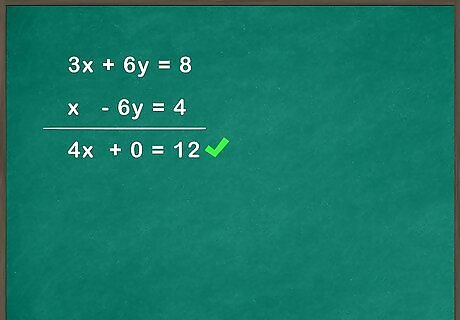
Add like terms. Now that you've lined up the two equations, all you have to do is add the like terms. You can take it one term at a time: 3x + x = 4x 6y + -6y = 0 8 + 4 = 12 When you combine it all together, you get your new product: 3x + 6y = 8 +(x - 6y = 4) = 4x + 0 = 12
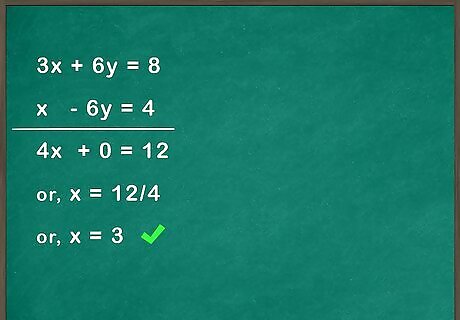
Solve for the remaining term. Once you've eliminated one of the variables by getting a term of 0 when you subtract variables with the same coefficient, you should just solve for the remaining variable by solving a regular equation. You can remove the 0 from the equation since it won't change its value. 4x + 0 = 12 4x = 12 Divide 4x and 12 by 3 to get x = 3

Plug the term back into the equation to find the value of the first term. Now that you know that x = 3, you just have to plug it into one of the original equations to solve for y. It doesn't matter which one you choose because the answer will be the same. If one of the equations looks more complicated than the other, just plug it into the easier equation. Plug x = 3 into the equation x - 6y = 4 to solve for y. 3 - 6y = 4 -6y = 1 Divide -6y and 1 by -6 to get y = -1/6 You have solved the system of equations by addition. (x, y) = (3, -1/6)
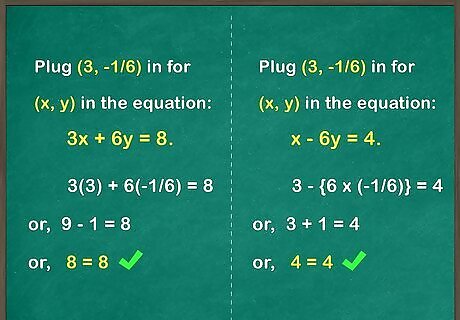
Check your answer. To make sure that you solved the system of equations correctly, you can just plug in your two answers to both equations to make sure that they work both times. Here's how to do it: Plug (3, -1/6) in for (x, y) in the equation 3x + 6y = 8. 3(3) + 6(-1/6) = 8 9 - 1 = 8 8 = 8 Plug (3, -1/6) in for (x, y) in the equation x - 6y = 4. 3 - (6 * -1/6) =4 3 - - 1 = 4 3 + 1 = 4 4 = 4
Solve by Multiplication
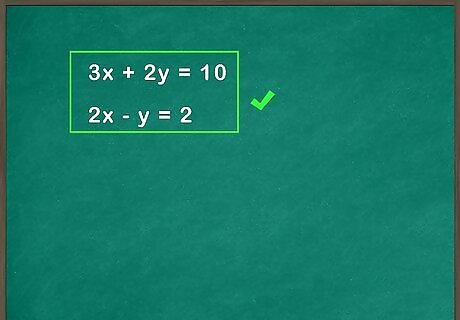
Write one equation above the other. Write one equation above the other by matching up the x and y variables and the whole numbers. When you use the multiplication method, none of the variables will have matching coefficients -- yet. 3x + 2y = 10 2x - y = 2
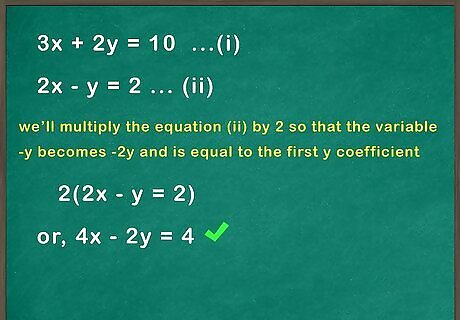
Multiply one or both equations until one of the variables of both terms have equal coefficients. Now, multiply one or both of the equations by a number that would make one of the variables have the same coefficient. In this case, you can multiply the entire second equation by 2 so that the variable -y becomes -2y and is equal to the first y coefficient. Here's how to do it: 2 (2x - y = 2) 4x - 2y = 4
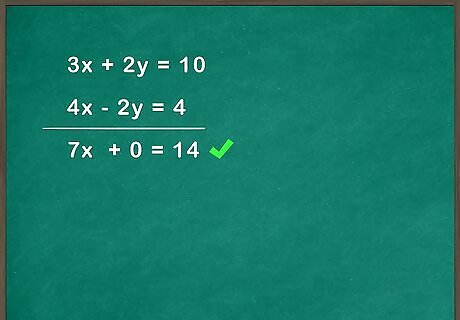
Add or subtract the equations. Now, just use the addition or subtraction method on the two equations based on which method would eliminate the variable with the same coefficient. Since you're working with 2y and -2y, you should use the addition method because 2y + -2y is equal to 0. If you were working with 2y and positive 2y, then you would use the subtraction method. Here's how to use the addition method to eliminate one of the variables: 3x + 2y = 10 + 4x - 2y = 4 7x + 0 = 14 7x = 14
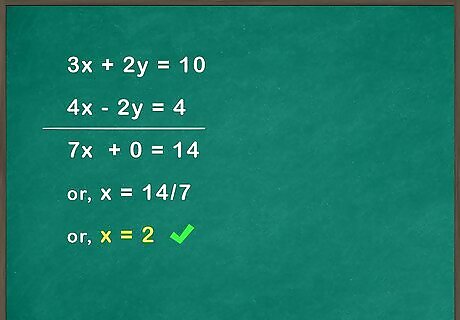
Solve for the remaining term. Just solve to find the value of the term that you haven't eliminated. If 7x = 14, then x = 2.
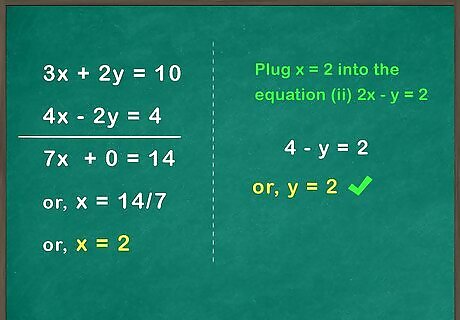
Plug the term back into the equation to find the value of the first term. Plug the term back into one of the original equations to solve for the other term. Pick the easier equation to do it faster. x = 2 ---> 2x - y = 2 4 - y = 2 -y = -2 y = 2 You have solved the system of equations by multiplication. (x, y) = (2, 2)
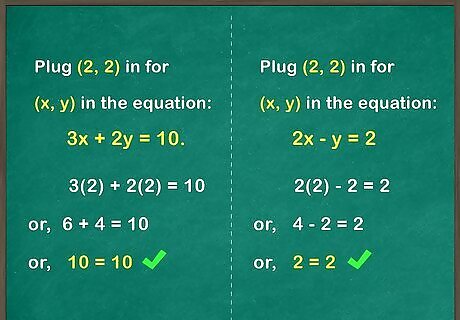
Check your answer. To check your answer, just plug the two values you found back into the original equations to make sure that you have the right values. Plug (2, 2) in for (x, y) in the equation 3x + 2y = 10. 3(2) + 2(2) = 10 6 + 4 = 10 10 = 10 Plug (2, 2) in for (x, y) in the equation 2x - y = 2. 2(2) - 2 = 2 4 - 2 = 2 2 = 2
Solve by Substitution
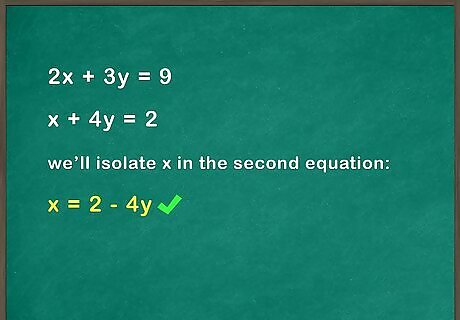
Isolate one variable. The substitution method is ideal when one of the coefficients in one of the equations is equal to one. Then, all you have to do is isolate the single-coefficient variable on one side of the equation to find its value. If you're working with the equations 2x + 3y = 9 and x + 4y = 2, you should isolate x in the second equation. x + 4y = 2 x = 2 - 4y
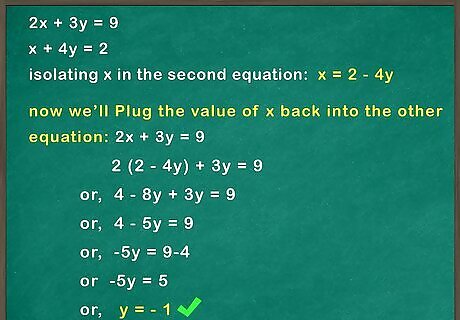
Plug the value of the variable you isolated back into the other equation. Take the value you found when you isolated the variable and replace that value instead of the variable in the equation that you did not manipulate. You won't be able to solve anything if you plug it back into the equation you just manipulated. Here's what to do: x = 2 - 4y --> 2x + 3y = 9 2(2 - 4y) + 3y = 9 4 - 8y + 3y = 9 4 - 5y = 9 -5y = 9 - 4 -5y = 5 -y = 1 y = - 1
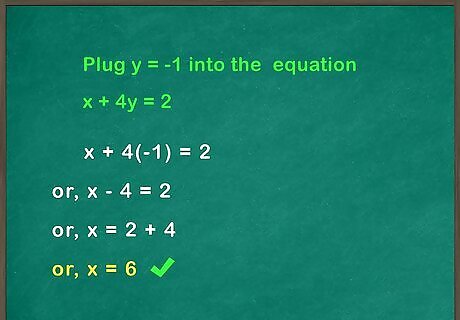
Solve for the remaining variable. Now that you know that y = - 1, just plug that value into the simpler equation to find the value of x. Here's how you do it: y = -1 --> x = 2 - 4y x = 2 - 4(-1) x = 2 - -4 x = 2 + 4 x = 6 You have solved the system of equations by substitution. (x, y) = (6, -1)
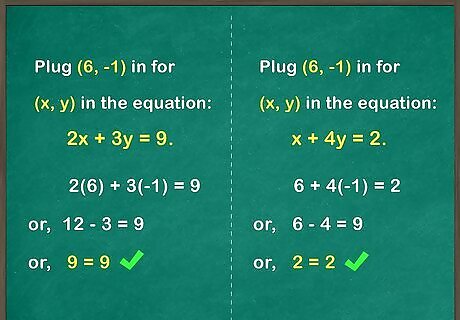
Check your work. To make sure that you solved the system of equations correctly, you can just plug in your two answers to both equations to make sure that they work both times. Here's how to do it: Plug (6, -1) in for (x, y) in the equation 2x + 3y = 9. 2(6) + 3(-1) = 9 12 - 3 = 9 9 = 9 Plug (6, -1) in for (x, y) in the equation x + 4y = 2. 6 + 4(-1) = 2 6 - 4 = 2 2 = 2











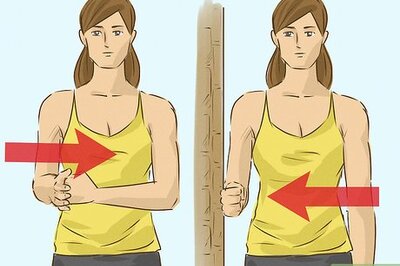

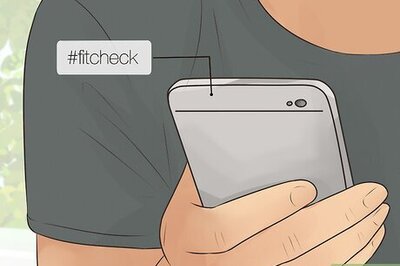



Comments
0 comment